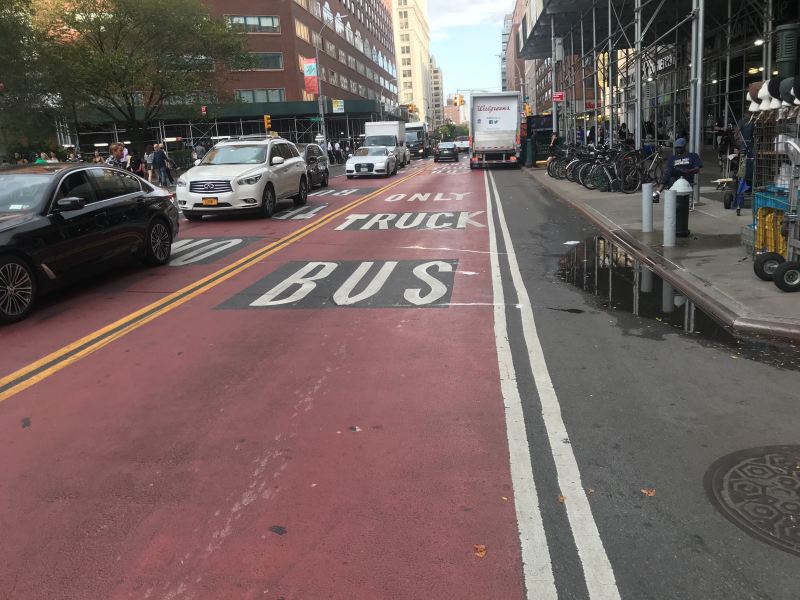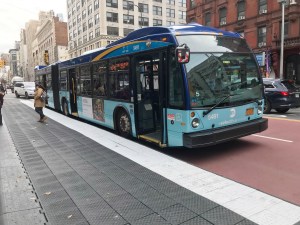The 14th Street Busway Starts Thursday — But Enforcement Won’t Start ‘Til December

B-Day is finally here!
After years of planning and months of litigation-related delays, the 14th Street Busway will make its long-awaited debut on Thursday morning — though drivers will get several months of grace period before being slapped with tickets for breaking the roadway’s car-free rules.
City officials on Wednesday revealed their slow approach to enforcement along the truck and bus priority route — which will bar cars except those making drop-offs or pickups every day from 6 a.m. to 10 p.m. between Third and Ninth avenues — saying the goal is compliance not punishment.
“It will take time for people to get used to how this new Busway is going to operate,” said Department of Transportation Commissioner Polly Trottenberg, as she laid out the city’s full enforcement strategy to make sure that drivers do not screw up the bus-priority route, which is expected to speed transit by 20 to 30 percent.
The multi-pronged enforcement effort includes:
- The city’s first-ever onboard bus-lane-enforcement cameras. They’ll be installed on the M14 routes by the end of November, but won’t start issuing tickets for 60 days.
- Stationary enforcement cameras on every block to catch drivers blocking bus lanes and for failing to exit 14th Street at the first available right turn after their pickup or drop-off. Those $50 tickets — rising by $50 to a maximum of $250 for every infraction in the same 12-month period — also won’t be issued for 60 days.
- An undisclosed number of Traffic Enforcement Agency officers to provide a human oversight to the street’s traffic situation. Those officers will also not write tickets for two months, but they will hand out warnings.
The lengthy pre-enforcement period has the backing of Transportation Alternatives, which has long sought this car-free transit-priority zone.
“The goal is deterrence, not penalization,” said the group’s Co-Deputy Director Marco Conner. “To achieve optimal deterrence, it is important that people feel they are being treated fairly; it results in greater compliance.”
Besides, added Trottenberg, once the enforcement kicks in, it will work really well.
“One thing we find with all of our camera programs is that most people who get a first ticket don’t get a second,” she said, suggesting that the escalating fine structure will discourage drivers from testing the system over and over again.
The city has been planning the “busway” for two years, yet many elements of it remain in question. For example:
How well will the in-bus cameras work?
The use of in-bus cameras certainly won’t be as effective as the image of vaporized cars provided last week by the MTA, but they will keep buses moving, said Acting MTA Bus Company President Craig Cipriano. Here’s how they’ll work: if a car is illegally parked in the busway, a bus will automatically take its picture. If the car remains in the busway, it will be photographed by the next passing bus. That second photo will lead to a ticket, issued by mail, Cipriano said.
Cities such as London and San Francisco have used in-camera buses to enforce bus lanes. Cipriano added that the cameras “worked so well in London that they actually took them off the buses when they implemented congestion pricing.”
Will unloading and loading take up all the curbside space?
The city will provide metered space for trucks to load and unload — and additional unmetered roadway space for cars making drop-offs or pickups to double-park next to those trucks. It is simply unclear how that will work. At a previous press conference, city officials said drivers could use these curbside parking spaces for up to a half hour.

Will drivers be able to turn off of 14th Street or will they block buses?
Although the busway design leaves space along the curb for most of the block (see middle segment of the graphic to the right), at the corners, the DOT has added bulb-outs to give pedestrians space to stand while they board the bus (see bottom segment).
Car drivers would also be in that “bus only lane” as they prepare to make their first right to legally exit 14th Street. Given pedestrian volumes in the area, it is unclear if cars will get out of the way of buses or be stuck waiting for pedestrians to finish crossing.
Trottenberg said that she didn’t foresee a huge problem because drivers will soon understand the difficulty of using 14th Street as a through street of any kind, so car volumes will drop dramatically.
About those car volumes…
The lawsuit against the city’s busway plan contends that the car-free roadway will just bleed automobiles onto the mostly residential streets to the north and south of 14th Street.
The DOT’s own “conservative” estimate predicted 1,000 extra cars per day on side streets. But the city also argued in the lawsuit that the number would likely be lower as some drivers switch to the M14 as it becomes more reliable because of the busway.
And because trucks can use 14th Street as a through-way, Trottenberg said they would stay off of surrounding streets.
She added on Wednesday that a similar concern came up when Toronto prioritized a streetcar on King Street in Downtown.
“It took a couple of weeks to settle in, but then traffic didn’t hugely impact the side streets, some of it went away and of some it spread itself further into the grid,” Trottenberg said — though did not mention that Toronto’s “grid” is different from New York’s in that King Street is flanked by commercial streets, not residential streets as in New York. The home of the Hockey Hall of Fame also removed a substantial amount of street parking.
Trottenberg said DOT would monitor the traffic effects of the new restrictions over the life of the pilot. The DOT’s monitoring will also be monitored by an outside firm hired at the urging of City Council Speaker (and Busway agnostic) Corey Johnson.
The good news
The busway, once it’s up and running at true capacity, will improve M14 speeds by 20 to 30 percent and shave five minutes per trip for bus line’s 27,000 daily riders, said DOT Deputy Commissioner for Traffic Eric Beaton. That’s a big deal for a bus that currently moves at around 4 miles per hour, according to the DOT (and 3.84 miles per hour during a Streetsblog test ride).
In addition to the vehicle restriction on 14th, the M14 was turned into an SBS line, which allows for all-door boarding at each stop along the route.
“We think it will very reliably be that fast, it won’t just be fast sometimes and slow other times,” Beaton told reporters. “With this kind of treatment, we’ll see buses go fast regularly, which means people can count on that travel time.”




